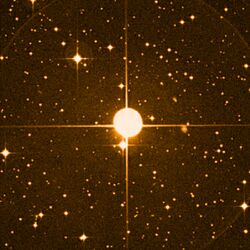Astronomy:HD 47536
| Observation data Equinox J2000.0]] (ICRS) | |
|---|---|
| Constellation | Canis Major |
| Right ascension | 06h 37m 47.61811s[1] |
| Declination | −32° 20′ 23.0405″[1] |
| Apparent magnitude (V) | +5.25[2] |
| Characteristics | |
| Evolutionary stage | giant[3] |
| Spectral type | K1 III[4] |
| B−V color index | +1.177±0.002[2] |
| Astrometry | |
| Radial velocity (Rv) | 79.64±0.13[1] km/s |
| Proper motion (μ) | RA: 107.755±0.053[1] mas/yr Dec.: 65.122±0.059[1] mas/yr |
| Parallax (π) | 7.9902 ± 0.0535[1] mas |
| Distance | 408 ± 3 ly (125.2 ± 0.8 pc) |
| Absolute magnitude (MV) | −0.17±0.15[5] |
| Details[5] | |
| Mass | 0.94±0.06 M☉ |
| Radius | 23.08+0.68 −0.81[6] R☉ |
| Luminosity | 177.2±2.3[6] L☉ |
| Surface gravity (log g) | 1.72±0.08 cgs |
| Temperature | 4,384+79 −64[6] K |
| Metallicity [Fe/H] | −0.68 dex |
| Rotation | 625 days[7] |
| Rotational velocity (v sin i) | 1.93±0.50[3] km/s |
| Age | 9.33±1.88 Gyr |
| Other designations | |
| Database references | |
| SIMBAD | data |
| Extrasolar Planets Encyclopaedia | data |
HD 47536 is a single[9] star in the southern constellation of Canis Major. It has an orange hue and is dimly visible to the naked eye with an apparent visual magnitude of +5.25.[2] The star is located at a distance of approximately 408 light years from the Sun based on parallax. It is drifting further away with a radial velocity of 80 km/s.[1]
This is an aging, metal-poor giant star with a stellar classification of K1 III.[4] It is about 9.3 billion years old with 94% of the mass of the Sun. Having exhausted the supply of hydrogen at its core, the star cooled and expanded to 23 times the Sun's radius.[6] The star is spinning slowly, taking 1.71 years to complete its sidereal rotation. It is radiating 177[6] times the luminosity of the Sun from its swollen photosphere at an effective temperature of 4,384 K.[6] As of 2015, at least one planet is known to orbit this star.[10]
Planetary system
A planetary companion to this star, HD 47536 b, was discovered in 2003 by a team led by J. Setiawan.[11][3] A second planet, HD 47536 c, was claimed in 2007.[12] However, a follow-up study by Soto et al. in 2015 failed to detect the signal of the second planet, so it remains unconfirmed.[10]
| Companion (in order from star) |
Mass | Semimajor axis (AU) |
Orbital period (days) |
Eccentricity | Inclination | Radius |
|---|---|---|---|---|---|---|
| b | ≥4.0±0.4 MJ | 1.12±0.005 | 434.9±2.6 | 0.3±0.1 | — | — |
| c (unconfirmed) | >6.98 MJ | 3.72 | 2500 | — | — | — |
See also
- HD 122430
- List of extrasolar planets
References
- ↑ 1.0 1.1 1.2 1.3 1.4 1.5 Vallenari, A. et al. (2022). "Gaia Data Release 3. Summary of the content and survey properties". Astronomy & Astrophysics. doi:10.1051/0004-6361/202243940 Gaia DR3 record for this source at VizieR.
- ↑ 2.0 2.1 2.2 Anderson, E.; Francis, Ch. (2012). "XHIP: An extended hipparcos compilation". Astronomy Letters 38 (5): 331. doi:10.1134/S1063773712050015. Bibcode: 2012AstL...38..331A.
- ↑ 3.0 3.1 3.2 Setiawan, J. et al. (2003). "Evidence of a sub-stellar companion around HD 47536". Astronomy and Astrophysics 398 (2): L19–L23. doi:10.1051/0004-6361:20021846. Bibcode: 2003A&A...398L..19S.
- ↑ 4.0 4.1 Houk, Nancy (1979). Michigan catalogue of two-dimensional spectral types for the HD stars. 3. Ann Arbor, Michigan: Dept. of Astronomy, University of Michigan. Bibcode: 1982mcts.book.....H.
- ↑ 5.0 5.1 da Silva, L. et al. (November 2006). "Basic physical parameters of a selected sample of evolved stars". Astronomy and Astrophysics 458 (2): 609–623. doi:10.1051/0004-6361:20065105. Bibcode: 2006A&A...458..609D.
- ↑ 6.0 6.1 6.2 6.3 6.4 6.5 Brown, A. G. A. (August 2018). "Gaia Data Release 2: Summary of the contents and survey properties". Astronomy & Astrophysics 616: A1. doi:10.1051/0004-6361/201833051. Bibcode: 2018A&A...616A...1G. Gaia DR2 record for this source at VizieR.
- ↑ Setiawan, J. et al. (July 2004). "Precise radial velocity measurements of G and K giants. Multiple systems and variability trend along the Red Giant Branch". Astronomy and Astrophysics 421: 241–254. doi:10.1051/0004-6361:20041042-1. Bibcode: 2004A&A...421..241S.
- ↑ "HD 47536". SIMBAD. Centre de données astronomiques de Strasbourg. http://simbad.u-strasbg.fr/simbad/sim-basic?Ident=HD+47536.
- ↑ Eggleton, P. P.; Tokovinin, A. A. (September 2008). "A catalogue of multiplicity among bright stellar systems". Monthly Notices of the Royal Astronomical Society 389 (2): 869–879. doi:10.1111/j.1365-2966.2008.13596.x. Bibcode: 2008MNRAS.389..869E.
- ↑ 10.0 10.1 10.2 Soto, M. G. et al. (August 2015). "RAFT - I. Discovery of new planetary candidates and updated orbits from archival FEROS spectra". Monthly Notices of the Royal Astronomical Society 451 (3): 3131–3144. doi:10.1093/mnras/stv1144. Bibcode: 2015MNRAS.451.3131S.
- ↑ "Distant World in Peril Discovered from La Silla: Giant Exoplanet Orbits Giant Star". ESO for the Public (Press release). Garching, Germany: European Southern Observatory. 22 January 2003. Retrieved 30 December 2012.
- ↑ Setiawan, J.; Weise, P.; Henning, Th.; Hatzes, A. P.; Pasquini, L.; Da Silva, L.; Girardi, L.; von Der Lühe, O. et al. (2008). "Planets Around Active Stars". Precision Spectroscopy in Astrophysics. ESO Astrophysics Symposia. pp. 201–204. doi:10.1007/978-3-540-75485-5_43. ISBN 978-3-540-75484-8.
External links
Coordinates: ![]() 06h 37m 47.6189s, −32° 20′ 23.045″
06h 37m 47.6189s, −32° 20′ 23.045″
 |


